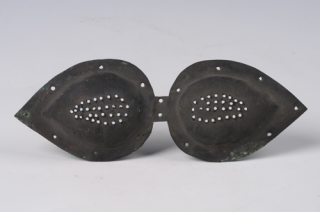Neuroscience
How Sunglasses Protect and Affect Your Eyes
Sunglasses provide eye protection and style but they don’t supercharge vision.
Updated August 7, 2023 Reviewed by Ray Parker
Key points
- Evidence suggests sunglasses make the process of using your eyes a bit easier, more comfortable, and safer.
- But sunglasses probably won't make your visual acuity any better.
- There's debate in physiological optics on whether reducing glare with sunglasses improves spatial vision.

For a thousand years, and probably much longer, humans have made contraptions to shade their eyes from bright light.
In the seventh century B.C., people living in central Asian deserts crafted spectacles of black metal punctured with dozens of tiny holes to protect their eyes. In snowy Tibet, people built sunshades out of wool, while Inuit people (inhabiting the Arctic and subarctic regions) carved bone visors with small rectangular or circular windows cut out.
Full disclosure: I am a habitual sunglass wearer. It seems obvious to me that you should protect your eyes with shades whenever possible. For the most part, evidence suggests that sunglasses make the process of using your eyes a bit easier, more comfortable, and safer. But sunglasses probably won't make your visual acuity any better.

Ultraviolet Protection
Ultraviolet and near-ultraviolet light (short-wavelength blue) cause a variety of cumulative damage to your eyes and tissue around the eyes, which sunglasses can help block. Over time, ultraviolet radiation (UV) can cause degeneration or damage to the conjunctiva (membranous outer surface of the eye), the cornea (just under the conjunctiva, the clear “shell” of the iris and pupil), and the lens (inside the iris, through which all light you see passes), where it can cause cataracts. It even poses a threat to the skin of your eyelid, which is more susceptible to UV damage than other patches of skin. UV light exposure also damages the light-sensitive retina at the back of your eye and can cause potentially blinding conditions like macular degeneration.
Most sunglasses do a decent job of removing UV light. Indeed, any piece of glass will remove most of it (though many sunglasses are made of plastic materials). Reputable manufacturers usually follow national and international standards for UV protection.
One other factor in UV protection is how much the sunglasses wrap around the eyes. Significant amounts of UV can sneak into your eyes from the side. Wider lenses are better from this standpoint. However, frontal illumination is more damaging due to the way light bends as it goes from the air into the structures of our eyes.
Glare
A primary advantage of dark spectacles is to reduce glare. Bright light from the sun itself, or sunlight reflected off shiny objects, can be both distracting and aversive and it can obscure objects, making them harder to make out or detect. Most sunglasses substantially lessen glare.
However, there is a long-running debate in physiological optics as to whether reducing glare with sunglasses improves spatial vision. The issue is that sunglasses reduce the intensity of both bright and dark parts of the scene. At lower overall light intensity, we need a bit more contrast between dark and light to detect a boundary compared to higher overall light intensities. For the most part, the advantage in acuity gained by reducing glare is probably offset by lower contrast sensitivity at lower overall intensity.
Can you reduce glare without sunglasses? This is the idea of "eye black." Eye black is a grease or strip applied under the eyes to reduce glare, often seen on football players. You can potentially lessen glare but still retain the high light intensity, where spatial vision is better. A 2003 study found that contrast sensitivity was somewhat improved by eye black.
This evidence is in line with studies suggesting that, in falcons, natural patches of black feathers under the birds' eyes serve the same purpose of glare reduction. But in humans, gains in acuity are small—if they exist at all. The 2003 study's main author helped start a business selling eye black three years before the paper's publication (a fact not noted in the paper). A follow-up study by a different group not involved in selling eye black found little if any effect. Even if eye black meaningfully reduces glare, it doesn't give UV protection, plus eye black isn't suited to everyday wear. Sunglasses are probably a better bet overall.
Polarized Lenses
Sunglasses can have a specific utility for vision, such as polarized lenses for fishing. This kind of sunglasses has a special filter that eliminates light of a particular polarization angle. For example, if you are looking toward the sun, its reflection in the water can be blocked, allowing you to see under the water much more clearly. In Ray-Bans, polarized lenses are denoted with a "P" on the front of the lens.
However, for daily use polarized lenses can be somewhat distracting. If you tilt your head with the glasses on, new regions of bright light can appear in places that were previously dark, but not because anything has moved. Polarized lenses also do nothing beyond what unpolarized lenses accomplish to reduce glare caused by direct sunlight. Personally, I prefer unpolarized lenses.
Sunglasses Can Affect How Others Perceive You
A study by vision scientists Isabelle Mareschal and Colin Clifford in 2013 suggests that we may assume that someone wearing sunglasses is looking directly at us, even if their gaze is pointed elsewhere. These researchers found that when viewers had trouble resolving the eyes of a synthetic face (due to noise added to the image of the face), people assumed the eyes were pointed directly at them, even when the synthetic face's eyes were "looking" to the side. The same likely applies when sunglasses obscure someone's eyes. This accords with daily experience. This may well be part of why people wear sunglasses: to give the impression of greater attentiveness or presence.
Indeed, sunglasses are as much an aesthetic accessory as eye protection. Famously, the Roman emperor Nero was said to prefer to view gladiator combat through an emerald. Presumably, this didn't usefully reduce glare, let alone enhance his vision, but was done to impress those around him (or maybe serve as a mirror spot for potential attackers behind him). So today the sunglasses on display at fashion events span from singer Pharrell William's tiny shades, which are reminiscent of Inuit snow goggles, to singer Beyoncé's outsize wraparounds, which should provide excellent UV protection to boot.
Copyright © 2023 Daniel Graham. Unauthorized reproduction of any content on this page is forbidden. For reprint requests, email reprints@internetinyourhead.com.
References
Dain, S. J. (2003). Sunglasses and sunglass standards. Clinical and Experimental Optometry, 86(2), 77-90.
De Broff, B. M., & Pahk, P. J. (2003). The ability of periorbitally applied antiglare products to improve contrast sensitivity in conditions of sunlight exposure. Archives of Ophthalmology, 121(7), 997-1001.
Horn, F. C., Erickson, G. B., Karben, B., & Moore, B. (2011). Comparison of low-contrast visual acuity between eye black and maxsight tinted contact lenses. Eye & Contact Lens, 37(3), 147-152.
Mareschal, I., Calder, A. J., & Clifford, C. W. (2013). Humans have an expectation that gaze is directed toward them. Current Biology, 23(8), 717-721.
Rubin, M. L. (1986). Spectacles: Past, present, and future. Survey of Ophthalmology, 30(5), 321–327. doi:10.1016/0039-6257(86)90064-0
Vrettos, M., Reynolds, C., & Amar, A. (2021). Malar stripe size and prominence in peregrine falcons vary positively with solar radiation: support for the solar glare hypothesis. Biology Letters, 17(6), 20210116.




